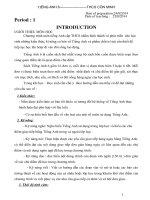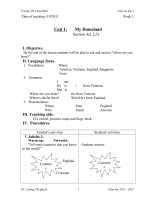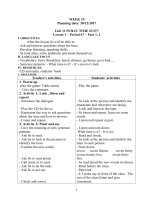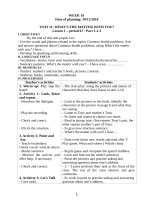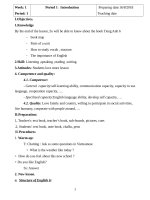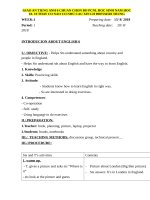Giáo án tiếng anh lớp 6 chọn bộ theo chương trình PTNLHS giáo án cả năm xuân nguyễn thị unit (12)
Bạn đang xem bản rút gọn của tài liệu. Xem và tải ngay bản đầy đủ của tài liệu tại đây (948.28 KB, 15 trang )
GIAOANDETHITIENGANH.BLOGSPOT.COM
UNIT 12: ROBOTS
Lesson 1: Getting Started – Robots and their work
I. Objectives:
By the end of this lesson, students can know some vocabulary and structure to talk about the
topic ‘robots’.
II. Language Focus:
1. Vocabulary: the lexical items related to the topic “Robots”.
2. Structures:
Could for past ability.
Will be able to for future ability.
III. Method: Communicative approach
IV. Teaching ads: Course book, CD player, picture.
V. Procedures:
Teach
- Ask Ss to look at the picture and answer the questions.
- Write Ss’ answers to question 3 on the board.
- Play the recording.
- Ask Ss if their guesses on the board are correct.
- Ask Ss to work independently.
- Allow them to share answers before discussing as class.
- Write the correct answers on the board.
- Ask Ss to give their answers without reading the conversation again. Then ask them to read the conversa
- Confirm the correct answers.
- T asks SS to quickly match each activity with its picture.
- Play the recording for Ss to check their answers, pausing after each phrase and asking them to repeat cho
- Demonstrate the game to the class first. Ask a more able S to help you. Then Ss play in groups.
GIAOANDETHITIENGANH.BLOGSPOT.COM
- Have Ss work in pairs to do this activity.
- Ask Ss to go around the class asking the questions.
- When Ss finished the survey, ask Ss to report the results.
GIAOANDETHITIENGANH.BLOGSPOT.COM
UNIT 12: ROBOTS
Lesson 2: A Closer Look 1
I. Objectives:
By the end of this lesson, students can Pronounce correctly the sounds // and // in
isolation and in context; Use the lexical items related to the topic “Robots”.
II. Language Focus:
1. Vocabulary: the lexical items related to the topic “Robots”.
2. Structures:
Could for past ability.
Will be able to for future ability.
III. Method: Communicative approach
IV. Teaching ads: Course book, CD player, picture.
V. Procedures:
Teacher’s Activities
Ss’ Activities
- Have Ss quickly match the verb
in column A with column B. then
play the recording for Ss check
their answers. Ask them to listen
and repeat.
- Correct their pronunciation.
- T whole class
- Ask Ss to write another word/
phrase for each verb.
- Pair-work
- Ask Ss to study Grammar Box.
Draw Ss’ attention to the form
and use of could by analyzing the
examples to illustrate.
- Have Ss do the grammar
exercise exercise individually.
Tell Ss refer to the form and use
of could in the Grammar Box if
they have any difficulty.
- T whole class
- Individual work
Content
* Presentation:
Vocabulary
1. Match the verbs in column A to
the words/ phrases in column B.
Then listen, check and repeat the
words/ phrases.
Key:
1. c
2. a
3. b
2. Write another word/ phrase for
each verb.
* Practice:
Grammar
Could
Example:
• She could swim at the age of 7.
• He couldn’t read until he was 6.
• Could you ride a bike when you
were in Year 5?
3. Put the words in the correct order.
Key:
1. Mary could do sums at the age
of 7.
2. Could you read and write when
Not
e
GIAOANDETHITIENGANH.BLOGSPOT.COM
- First, model this activity with a
more able student. Remind Ss that
they only use the information
from the table in 4 to ask and
answer about what the famous
robot Ongaku could or couldn’t
do two years ago.
- Pair-work
you were 6?
3. Robots could lift heavy things
some years ago.
4. Robots couldn’t move easily
until recent years.
4. Read the conversation about the
famous robot Ongaku. Ask and
answer questions about what it
could/ couldn’t do two years ago.
Example:
A: Could Ongaku lift heavy thing
- Individual work
- Write 2 examples of what he/
two years ago?
she could/ couldn’t do when at
B: Yes, it could.
primary school on the board. Ask
5. Write three things you could do
them to write.
and three things you couldn’t do
when you were in primary school.
- Individual work
Share your sentences with your
- Model the sound // and //
partner.
first and let Ss see how the
Pronunciation // and //
sounds are formed. Ask Ss to
- Pair-work
6. Listen and repeat. Pay attention
practice the sounds together.
to the sound // and //. Then in
- Ask them to put the words in the
pairs put the words in the correct
correct column.
column.
//
- Individual work
voice
- Ask Ss to listen while T play the
boy
recording. Play the recording
toy
again and ask Ss to circle the
noisy
words they hear. Ask ss to check
boil
their answers.
7. Listen to the sentences. Circle the
word you hear.
Key:
1. Oil
2. Cow
3. Ouch!
4. Bow
- Ask Ss to listen while T play the
recording. Play the recording
again and ask Ss to chant along.
- Pair -work
* Production:
8. Listen and practice the chant.
Notice the sound // and //
*Homework:
- Learn vocabulary by heart.
- Prepare the next lesson
GIAOANDETHITIENGANH.BLOGSPOT.COM
(A closer look 2)
UNIT 12: ROBOTS
Lesson 3: A Closer Look 2
I. Objectives:
By the end of this lesson, students can use will be able to for future ability and could for past
ability.
II. Language Focus:
1. Vocabulary: the lexical items related to the topic “Robots”.
2. Structures:
Could for past ability.
Will be able to for future ability.
III. Method: Communicative approach
IV. Teaching ads: Course book, CD player, picture.
V. Procedures:
Teacher’s Activities
Ss’ Activities
- Ask Ss to study the Grammar
- T-Whole class
Box. Draw Ss’ attention to the
form and use of will be able to
by analyzing the examples in the
Grammar Box.
- Remind Ss that will be able to
is used to talk about ability in
the future. Then ask Ss to give
some more examples.
Content
* Warm-up:
Grammar
Will be able to
We use Will be able to talk about
ability in the future.
Example:
• She will be able to ride a bike
next year.
• He won’t be able to read or write
until he is 6.
• Will robots be able to talk to
people in the future?
* Practice:
- Ask Ss to read the instructions. - Individual work 1. Put the words in the correct order.
Use the example to make Ss
Key:
clear about what they should
1. In 2030, robots will be able to do
do. Ask Ss to do the grammar
many things like humans.
exercise individually.
- Pair-work
2. Will robots be able to talk to us
- Have Ss compare their answers
then?
in pairs before checking with
3. Robots won’t be able to play
the whole class.
football.
4. Will robots be able to recognize
Not
e
GIAOANDETHITIENGANH.BLOGSPOT.COM
- Individual work
- Ask Ss to read the instructions.
Use the example to make Ss
clear about what they should
do.
- Ask Ss to work individually and
share their sentences with their
partners. Call some Ss to say
- Pair-work
their sentences in front of the
class.
- First model this activity with a
more able student. Remind Ss
to ask and answer questions
- Individual work
about the activities in 2. Have Ss
work in pairs.
- Ask Ss to read and complete
the sentences individually. Have
them look back the Grammar
Boxes if necessary.
- Pair-work
- Ask Ss to read the instructions.
Explain to make Ss clear about
what they should do.
- Have Ss compare their answers
in pairs before checking with
the whole class.
- First model this activity with a - Pair-work
more able student. Ask Ss to
look at the information from the
table below and tell your
partner what Kitty could do in
the past, can do now and will be
able to do in the future.
our face?
2. Will you be good at English when
you are in Year 8?
Example:
A: I will/ won’t be able to read an
English book when you are in Year 8?
B: Yes, I will./ No, I won’t.
3. Work in pairs. Ask and answer the
questions about the activities in 2. Tell
the class about your partner.
4. Fill the gaps with can, can’t, could,
couldn’t, will be able to or won’t be
able to.
Key:
1. couldn’t
2. will be able to
3. could; can’t
4. won’t be able to
5. can
5. Complete the sentences. Use will be
able, can, could, and the verbs from
the box.
Key:
1. will be able to recognize
2. can make
3. could do
4. can guard
* Production:
6. Look at the information from the
table below and tell your partner
what Kitty could do in the past, can
do now and will be able to do in the
future.
Example:
In the past, Kitty could lift heavy
things. Now, it can lift heavy things…
GIAOANDETHITIENGANH.BLOGSPOT.COM
*Homework:
- Practice more.
- Prepare next lesson
(Communication)
GIAOANDETHITIENGANH.BLOGSPOT.COM
UNIT 12: ROBOTS
Lesson 4: Communication
I. Objectives:
By the end of this lesson, students can talk about what robots can do.
II. Language Focus:
1. Vocabulary: the lexical items related to the topic “Robots”.
2. Structures:
Could for past ability.
Will be able to for future ability.
III. Method: Communicative approach
IV. Teaching ads: Course book, CD player, picture.
V. Procedures:
Teacher’s Activities
- Before Ss open their books, ask
them some questions.
Ss’ Activities
- T whole class
- Have Ss read the interview and
ask them to look carefully at the
pictures of three robots and
guess the missing word for each
gap in the interview.
- Play the recording and allow Ss
to fill in the gaps as they listen.
- Ask Ss to share their answers in
pairs.
- T whole class
- Ask Ss to move around and ask
different classmates what skills
they want their robots to have.
Remind them to write the names
of the people they interview and
- T whole class
- Pair-work
Content
* Presentation:
Questions:
• What skills would you like a
robot to have?
• And what skills do the two
robots Ongaku and Kitty have?
* Practice:
1. Listen to the radio program form
4Teen News. Then fill in each gap
with the word you hear.
Welcome to ‘Technology and you’.
Today we ask our friends around the
world to tell is about their robots.
Key:
1. words
2. shoes
3. first
4. school
5. water
2. Interview three people about
what skills they want their robots to
have. Note their answers in the
table below.
(Page 63)
Not
e
GIAOANDETHITIENGANH.BLOGSPOT.COM
note the answers in table 2.
- When Ss have finished the
interview, have Ss practice
reporting the results of their
interviews in pairs.
- Pair-work
- Choose some Ss to report the
- T whole class
results of the interviews in front
of the class. After each student
has finished his/ her report, invite
some comments from other Ss.
Then make comments and
correct any common errors.
- What abilities does he/ she want
his/ her robots to have?
* Production:
3. Report your results to the class.
*Homework:
- Prepare the next lesson :
(Skill 1)
GIAOANDETHITIENGANH.BLOGSPOT.COM
UNIT 12: ROBOTS
Lesson 5: Skill 1
I. Objectives:
By the end of this lesson, students can talk and read for specific information about types of
robots and their abilities or skills.
II. Language Focus:
1. Vocabulary: the lexical items related to the topic “Robots”.
2. Structures:
Could for past ability.
Will be able to for future ability
III. Method: Communicative approach
IV. Teaching ads: Course book, CD player, picture.
V. Procedures:
Teacher’s Activities
- Ask Ss to look at the picture of
robot show. And ask them some
questions.
- Ask SS to scan the passage and
underline the words in the box.
Help Ss work out the meanings of
Ss’ Activities
- Group-work
Content
* Presentation:
Questions:
1. Where do you think the robot
show is?
2. What types of robots are there
in the show?
3. Would you like to go to the
robot show?
4. Why? Why not?
* Practice:
- Individual work 1. Find these words or phrases in the
text below. What so they mean?
- Individual work
- Ask Ss to read the text again and
answer the questions. Ask them
to note where they found the
information that helped them to - Pair-work
answer the questions.
- Ask Ss to compare their answers
with a classmate before
discussing them as a class.
space robots
apart from
types
space stations
planet
2. Read the news report on the
international robot show. Then
answer the questions.
Key:
1. A robot show
2. Young people are interested in
home robots.
3. The children like to see them.
Not
e
GIAOANDETHITIENGANH.BLOGSPOT.COM
- Pair-work
- Ask Ss to scan the passage again
and find the detailed information
to complete the table. Ask Ss to
note where they found the
information that helped them to
answer the questions.
- Confirm Ss’ answers ans give
feedback.
3. Read the text again and fill the
table below.
Key:
Home robots: cook, make tea or
coffee, lean the house, and do the
washing.
Teaching robots: help children
study, teach them English, literature,
and other subjects; help children
improve their English pronunciation.
Worker robots: build houses,
buildings.
Doctor robots: help sick people
Space robots: build space stations
- Individual work
on the Moon and other planets.
- Brainstorm ideas for additional
everyday activities that a robot
can help with. Ask Ss to write
what they think each type of
robot will able to do in the
future.
- Ask SS to work in groups and
take turns talking about types of
robots and what they will be able
to do in the future.
4. There are worker robots,
doctor robots, and space
robots.
4. Write what you think each type of
robot will able to do in the future.
- Group-work
* Production:
5. Work in groups. take turns talking
about types of robots and what they
will be able to do in the future. Can
you think of other types of robots?
*Homework:
- Prepare the next lesson :
(Skill 2)
GIAOANDETHITIENGANH.BLOGSPOT.COM
UNIT 12: ROBOTS
Lesson 6: Skill 2
I. Objectives:
By the end of this lesson, students can listen to get specific information about different
options of what robots will be able to do in the future.
II. Language Focus:
1. Vocabulary: the lexical items related to the topic “Robots”.
2. Structures:
Could for past ability.
Will be able to for future ability
III. Method: Communicative approach
IV. Teaching ads: Course book, CD player, picture.
V. Procedures:
Teach
- Ask Ss to tick which statements about robots they agree or disagree with and then allow them to share w
- Ask Ss to read the instructions carefully and remind them to remember the names of people in the conve
- Play the recording and ask Ss to write down the names.
- Play the recording again for Ss to check their answers.
- Ask Ss to study statements carefully. Play the recording again and have Ss choose the correct answers as
- Play the recording again for Ss to check their answers.
- Ask Ss to work independently and complete the paragraph with the phrases or sentences from the box.
- Confirm the Ss’ answers.
GIAOANDETHITIENGANH.BLOGSPOT.COM
- Ask Ss to write their paragraph individually based on the suggestions in the book.
UNIT 12: ROBOTS
Lesson 7: Looking Back
I. Objectives:
By the end of this lesson, students can review some vocabulary and grammar
they’ve learn in unit 12.
II. Language Focus:
1. Vocabulary: the lexical items related to the topic “Robots”.
2. Structures:
Could for past ability.
Will be able to for future ability
III. Method: Communicative approach
IV. Teaching ads: Course book, CD player, picture.
V. Procedures:
Teacher’s Activities
- Ask SS to write the words in
their notebooks individually.
- Correct the exercise as a
class. Let Ss repeat the
phrases.
- Ask Ss to fill in the gaps with
the verbs form the box.
-Ask Ss to do the exercise
individually. Then SS check
their answers with their
partner
- Get feedbacks and correct if
necessary
- Ask Ss to do the exercise
Ss’ Activities
- Individual
work
- Individual
work
- Individual
work
- Individual
work
Content
* Presentation:
Vocabulary
1. Write the correct words to combine
the phrases.
Key:
1. cut
2. lift
3. tea
2. Fill in the gaps with the verbs form
the box.
Key:
1. guard
2. make
* Practice:
Grammar
3. Read and complete the interview
about home robots with will be able to
or won’t be able to.
Key:
1. Will be able to
2. Won’t be able to
3. Will be able to
4. Will (home robots) be able to
5. Won’t be able to
4. Make questions with these words.
What are the positive and negative
No
te
individually. Then SS check
their answers with their
partner
- Ask some Ss to write their
answers on the board. Give
feedback.
answers to these questions.
Key:
1.Will robots be able to make coffee in
the future? – Yes, they will/ No, they
won’t.
2.Could he ride a bike when he was in
Year 6? – Yes, he could/ No, he
couldn’t.
3.Can you do the dishes? – Yes, I can/
No, I can’t.
- Pair-work
- Ask Ss to write what they
could do when you were 10,
what they can do now, and
what they will be able to do
after they finish Year 6.
- Ask them to ask and answer
questions with a partner.
- Have Ss read the questions
and answers once or twice.
Then ask them to match the
questions with the correct
answers.
5. Write what you could do when you
were 10, what you can do now, and
what you will be able to do after you
finish Year 6.
Example:
A: Could you swim when you were ten?
B: Yes, I could.
- Individual
work
* Production:
Communication
6. Match the questions with the correct
answers.
Key:
1. c
2. d
Finished! Now you can………
*Homework:
- Do “project” on page 57.
- Prepare next lesson :
(Review 4)


